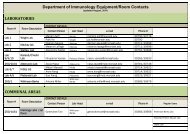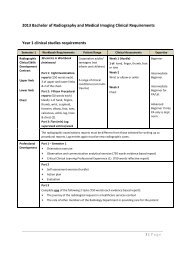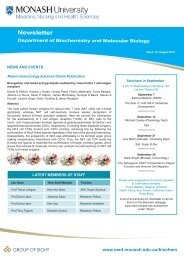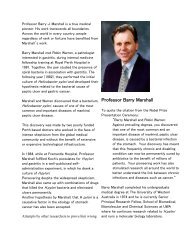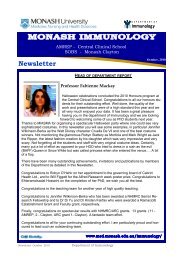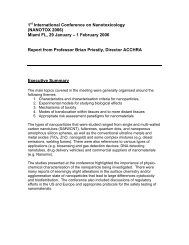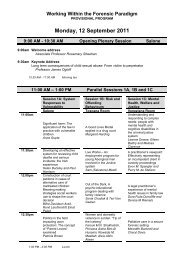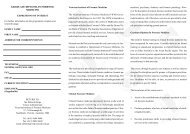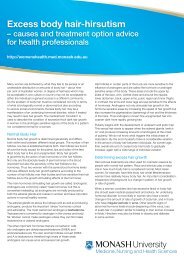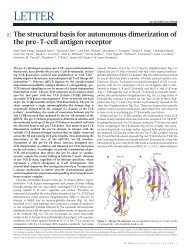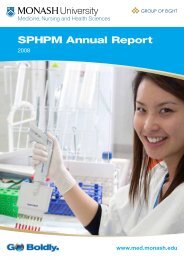Newsletter - Faculty of Medicine, Nursing and Health Sciences ...
Newsletter - Faculty of Medicine, Nursing and Health Sciences ...
Newsletter - Faculty of Medicine, Nursing and Health Sciences ...
You also want an ePaper? Increase the reach of your titles
YUMPU automatically turns print PDFs into web optimized ePapers that Google loves.
Pr<strong>of</strong> Trevor Lithgow continued<br />
TJL lab, University <strong>of</strong> Melbourne, 2004<br />
Front: Trevor, Dejan Bursac (WEHI),<br />
Lena Burri (Aker BioMarine Antarctic),<br />
Michael Dagley (McEwen Centre for<br />
Regenerative <strong>Medicine</strong>, Toronto),<br />
Katherine Vascotto (<strong>Nursing</strong>)<br />
Rear: Nickie Chan (CalTech), Joanne<br />
Hulett/Hildebr<strong>and</strong> (WEHI), Ian Gentle<br />
(University <strong>of</strong> Freiburg).<br />
TJL Lab 2012<br />
Back: Victoria Hewitt, Miguel Shingu-<br />
Vasquez, Chaille Webb, Hsin-Hui Shen<br />
Front: Trevor Lithgow, Matthew Belous<strong>of</strong>f,<br />
Denisse Leyton, Rhys Dunstan, Eva<br />
Heinz<br />
Trevor <strong>and</strong> his son, Maro.<br />
CONTACT US:<br />
Department <strong>of</strong> Biochemistry <strong>and</strong> Molecular Biology<br />
<strong>Newsletter</strong>: April 2011, Issue 22<br />
Jeff Schatz is one <strong>of</strong> the greatest advocates for teaching being part-<strong>and</strong>-parcel <strong>of</strong> research. He is famous for<br />
his lecturing workload (<strong>and</strong> the undergraduates in Basel love him) <strong>and</strong> famous too for having occasionally<br />
taken only a stick <strong>of</strong> chalk to scientific meetings for his plenary presentations. The years under his influence<br />
left me inspired <strong>and</strong> in no doubt that a teaching <strong>and</strong> research position was the career choice for me. I returned<br />
to Melbourne <strong>and</strong>, after a couple <strong>of</strong> years as a Level B Lecturer at La Trobe getting my first ARC grants to<br />
start up my own laboratory, I took a Level C position at The University <strong>of</strong> Melbourne. When I arrived, the<br />
University was planning the first inception <strong>of</strong> its Biomedical <strong>Sciences</strong> degree, <strong>and</strong> I was given the “opportunity”<br />
<strong>of</strong> designing the curriculum for three new subjects <strong>and</strong> serving as coordinator (convenor) for all three. That sort<br />
<strong>of</strong> workload should have been terrible for an ECR, but we rolled up our sleeves <strong>and</strong> ensured that three very<br />
special subjects were created. The student feedback was always very positive, <strong>and</strong> my research ran in a way<br />
that I was both happy with <strong>and</strong> proud <strong>of</strong>. I enjoyed the ten years that I spent at The University <strong>of</strong> Melbourne,<br />
<strong>and</strong> I miss teaching.<br />
Over that time the focus <strong>of</strong> research in my lab evolved from following the pathway by which relatively simple<br />
“tail-anchored proteins”, like Bcl-2 <strong>and</strong> its cousins, are inserted into the mitochondrial outer membrane, to<br />
looking at the assembly <strong>of</strong> more complex proteins <strong>of</strong> beta-barrel architecture. We identified <strong>and</strong> characterized<br />
molecular machines that drive these processes <strong>and</strong> this, in turn, led to a growing awareness that the<br />
molecular machines doing the job in mitochondria were inherited from the bacterial ancestors <strong>of</strong> these<br />
organelles.<br />
My move to our Department at Monash was made possible by an ARC Federation Fellowship awarded to<br />
investigate the bacterial <strong>and</strong> mitochondrial machines in parallel: comparing the mitochondrial system <strong>and</strong> the<br />
bacterial system for insight into evolution, for a better underst<strong>and</strong>ing <strong>of</strong> how they both function, <strong>and</strong> for any<br />
sniff <strong>of</strong> practical applications that might flow from inhibiting this process in bacterial pathogens. Our research<br />
effort is running really well, the team is smiling (pictured) <strong>and</strong> the facilities at Monash for this sort <strong>of</strong> work<br />
are better than anywhere; I honestly don’t think our current research could be done so well anywhere else.<br />
For me though, the best thing about the move to Monash was being part <strong>of</strong> the new Unit for Host-Pathogen<br />
Molecular Biology; for the collegiality between the research groups <strong>and</strong> the “buzz” <strong>of</strong> so much exciting new<br />
research. The Unit has recruited many new staff <strong>and</strong> students <strong>and</strong> has resulted in Monash securing new<br />
grants <strong>and</strong> fellowships from the ARC, NHMRC <strong>and</strong> international sources. The other five group leaders are<br />
ECRs <strong>and</strong> moved to Monash to start-up new laboratories. They have or are looking towards teaching <strong>and</strong><br />
research positions. They’ve come from training in the best labs around the world, with new ideas, new<br />
research directions <strong>and</strong> new approaches to big, exciting questions ... stop me if you think that you’ve heard<br />
this one before [3].<br />
[1] Vestweber, D., Brunner, J., Baker, A. & Schatz, G. (1989) A 42K outer-membrane protein is a component<br />
<strong>of</strong> the yeast mitochondrial protein<br />
import site. Nature 341: 205-209<br />
[2] Schatz, G. (2012) The fires <strong>of</strong> life. Annu. Rev. Biochem. 81 (in press)<br />
[3] Morrisey & Marr, J. (1987) Strangeways here we come. Sire records<br />
Pr<strong>of</strong> Lithgow’s Webpage: http://www.med.monash.edu.au/biochem/staff/lithgow.html<br />
Monash University, Ground Floor, Building 77, Wellington Road, Clayton VIC 3800 Australia<br />
Website: www.med.monash.edu.au/biochem<br />
Tel: +61 3 990 29400 Fax: +61 3 990 29500<br />
Content <strong>and</strong> Layout: Yvonne.Dooley@monash.edu Photography: MNHS Multimedia Services<br />
Department <strong>of</strong> Biochemistry <strong>and</strong> Molecular Biology<br />
Page 3





